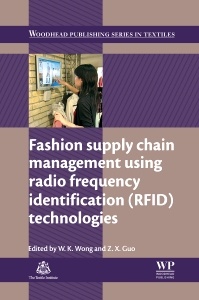Fashion Supply Chain Management Using Radio Frequency Identification (RFID) Technologies Woodhead Publishing Series in Textiles Series
Coordonnateurs : Wong Calvin, Guo Z. X.

Fashion Supply Chain Management Using Radio Frequency Identification (RFID) Technologies looks at the application of RFID technologies in such areas as order allocation, garment manufacturing, product tracking, distribution and retail. As supply chains in the textiles and fashion industry become ever more complex and global, and as the shift to mass customization puts more pressure on a rapid and flexible response to customer needs, monitoring and improving supply chain efficiency in the industry becomes crucial. Radio frequency identification (RFID) technologies offer a unique opportunity to achieve these goals.
This book reviews the role of RFID technologies in the textiles and fashion supply chain to improve distribution, process management and product tracking, garment manufacturing, and assembly line operations. It also explores how RFID technologies can improve order allocation in the supply chain, and how these technologies can also be used for intelligent apparel product cross-selling. Its chapters also discuss measuring the impact of RFID technologies in improving the efficiency of the textile supply chain, and modeling the effectiveness of RFID technologies in improving sales performance in fashion retail outlets.
Fashion Supply Chain Management Using Radio Frequency Identification (RFID) Technologies is a comprehensive resource for academic researchers, industry managers, and professionals within the fashion industry.
Contributor contact details
Woodhead Publishing Series in Textiles
1. The role of radio frequency identification (RFID) technologies in the textiles and fashion supply chain: an overview
Abstract:
1.1 Introduction
1.2 From barcode to RFID technology
1.3 Comparing barcode and RFID technologies
1.4 RFID technology
1.5 RFID applications in the fashion supply chain
1.6 References
2. The role of radio frequency identification (RFID) technologies in improving distribution and retail operations in the fashion supply chain
Abstract:
2.1 Introduction
2.2 Assessing the feasibility of using RFID technology: process reengineering
2.3 Assessing the feasibility of using RFID technology: profitability analysis
2.4 Using RFID technology in practice: the RFID Fashion Pilot (RFP) project
2.5 Sources of further information and advice
2.6 Acknowledgements
2.7 References
3. The role of radio frequency identification (RFID) technologies in improving process management and product tracking in the textiles and fashion supply chain
Abstract:
3.1 Introduction
3.2 Using RFID in supply chains: an overview
3.3 The use of RFID technology in fashion and textile supply chains (FTSC)
3.4 Using RFID technology in practice: the use of case studies
3.5 Case studies in the use of RFID technology: background and results
3.6 Conclusion
3.7 Acknowledgement
3.8 References
4. The role of radio frequency identification (RFID) technologies in improving garment manufacturing operations
Abstract:
4.1 Introduction
4.2 The business value of RFID technology in garment manufacturing operations
4.3 Using RFID technology in garment manufacture: a case study
4.4 Implementing an RFID-based manufacturing process management system
4.5 Assessing the effectiveness of RFID technology: data collection and analysis
4.6 The business value of the RFID-based manufacturing process management system
4.7 Factors in successful implementation of an RFID-based manufacturing process management system
4.8 Lessons learned from the case study
4.9 Conclusion
4.10 Acknowledgements
4.11 References
5. The role of radio frequency identification (RFID) technologies in improving garment assembly line operations
Abstract:
5.1 Introduction
5.2 Key issues in developing flexible assembly lines (FALs)
5.3 Modelling flexible assembly lines (FALs)
5.4 Intelligent decision support system for production control on flexible assembly lines (FALs)
5.5 Testing the effectiveness of the intelligent production control decision support (PCDS) system
5.6 Conclusion
5.7 Acknowledgement
5.8 References
6. Improving order allocation in fashion supply chains using radio frequency identification (RFID) technologies
Abstract:
6.1 Introduction
6.2 Production and distribution in the European apparel industry
6.3 Order and delivery models of apparel products
6.4 Warehouse-based versus flexible garment distribution forms
6.5 Use of RFID technology for garment allocation to fulfil customer orders
6.6 Software support for garment allocation
6.7 The benefits of using RFID technology
6.8 Conclusion and future trends
6.9 Sources of further information and advice
6.10 Acknowledgement
6.11 References
7. Intelligent apparel product cross-selling using radio frequency identification (RFID) technology for fashion retailing
Abstract:
7.1 Introduction
7.2 RFID-enabled Smart Dressing System (SDS)
7.3 Intelligent Product Cross-selling System (IPCS)
7.4 Implementation of the RFID-enabled SDS and IPCS
7.5 Evaluation of the RFID-enabled SDS
7.6 Assessing the role of RFID technology in fashion retailing
7.7 Conclusion
7.8 Acknowledgement
References
8. Measuring the impact of radio frequency identification (RFID) technologies in improving the efficiency of the textile supply chain
Abstract:
8.1 Introduction
8.2 Methodology
8.3 Industry distribution of RFID adoption in North America
8.4 Comparison of clothing and textiles RFID adopters with other RFID adopters
8.5 Supply chain performance differences between apparel and textiles RFID adopters and general manufacturing RFID adopters
8.6 Conclusion
8.7 References
9. Modeling the effectiveness of radio frequency identification (RFID) technologies in improving sales performance in fashion retail outlets
Abstract:
9.1 Introduction
9.2 Assessing the value of RFID technology
9.3 Modeling retail store operations
9.4 Case study: Miroglio Fast Fashion
9.5 Modeling of store operations at Miroglio
9.6 Model testing
9.7 Assessing the impact of RFID technology
9.8 Assessing return on investment from RFID technology
9.9 Conclusion and future trends
9.10 Acknowledgements
9.11 Appendix: full list of the equations of the system dynamics model
9.12 References
Index
- Looks at the application of RFID technologies in order allocation, garment manufacturing, product tracking, distribution, and retail
- Reviews RFID technologies in the textiles and fashion supply chain for improving distribution, process management and product tracking, garment manufacturing, and assembly line operations
- Focuses on measuring the impact of RFID technologies on efficiency, and modeling the effectiveness of RFID technologies in improving retail outlet sales
Date de parution : 01-2014
Ouvrage de 256 p.
15.5x23.2 cm



